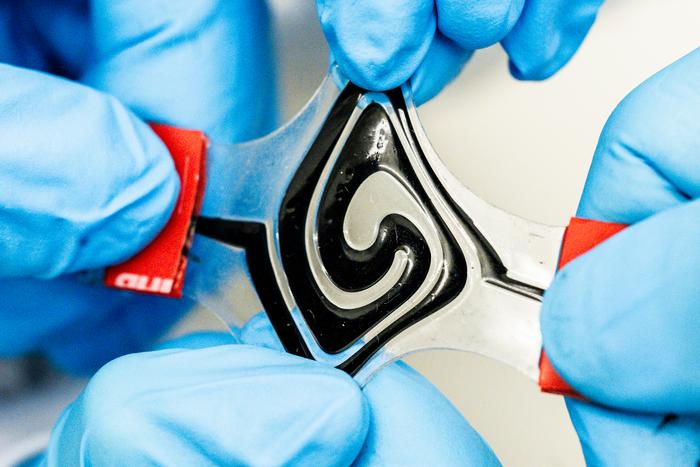In an innovative leap forward for energy storage technology, researchers at Linköping University have unveiled a groundbreaking type of battery characterized by its ability to adapt to any shape. This development ushers in the era of flexible electronics, potentially transforming the way batteries are integrated into a wide array of devices. The research findings, featured in the esteemed journal Science Advances, emphasize the potential applications of this soft battery in various fields like wearable technology, medical devices, and even soft robotics.
The new battery design utilizes electrodes that exist in a fluid state, likened to the texture of toothpaste. This unique characteristic permits the battery to be molded into various forms, thanks to its adaptability. Aiman Rahmanudin, an assistant professor at Linköping University, elucidates that this breakthrough enables the shaping of batteries through 3D printing methods, thereby paving the way for technologies that were previously limited by rigid battery designs. By removing these constraints, the researchers are directly addressing the needs of contemporary gadgets set to proliferate in the coming decade.
Experts predict that more than a trillion devices will connect to the Internet within just ten years. The anticipated advancements extend beyond conventional electronics like smartphones and tablets, reaching into burgeoning sectors such as wearable medical devices. Examples include insulin pumps, pacemakers, hearing aids, and various health-monitoring sensors. Future innovations may also encompass soft robotics, electronic textiles, and intricate nerve implants. Given this expanding landscape, the demand for batteries that seamlessly integrate with these devices without hindering user experiences becomes ever more critical.
In light of this, the team stresses that the evolution of battery design must evolve in tandem with these technologies. Rahmanudin highlights that conventional batteries are bulky and rigid, constraining their utility. With the introduction of a fluid battery, design limitations that have historically hindered advancements in technical integration are lifted. This soft and conformable battery could redefine the aesthetics and functionality of electronics in a way that was previously thought impossible.
The research team, which operates within the Laboratory of Organic Electronics, has tackled one of the key challenges in battery design: the balance between capacity and rigidity. Traditionally, the relationship between active materials required for higher energy capacities led to thicker, stiffer electrodes—making them unsuitable for innovative applications. However, this new approach promises a captivating solution. By turning electrodes into a liquid form, the research team has showcased a revolutionary design that allows for higher capacity while maintaining softness and flexibility, effectively decoupling these two characteristics.
Historically, there have been attempts to create soft and stretchable batteries, generally relying on mechanical systems, such as rubbery composites or sliding connections. Such methods often failed to address the core issue of rigidity, limiting their functionality. The new fluid battery paradigm radically alters this dynamic, achieving a balance where capacity can indeed exist independently of rigidity, a feat only recently realized as described by Rahmanudin.
Previous explorations into fluid electrodes have met with lackluster success, often reliant on liquid metals like gallium. While functional as an anode, these materials presented risks such as solidification during charging and discharging, which jeopardized their fluid nature. Furthermore, many past iterations employed rare materials, raising significant environmental concerns linked to extraction and processing. The Linköping team has pivoted from this approach by utilizing conductive plastics, known as conjugated polymers, along with lignin, a renewable byproduct from the paper industry.
This transformative approach not only lends sustainability to battery production but also emphasizes circular economy principles. The inclusion of lignin as a primary component allows for abundant supply chains, minimizing the ecological footprint associated with battery materials. The innovative fluid battery supports recharging and discharging cycles exceeding 500 times while maintaining optimum performance, even when stretched to twice its original length. Such resilience in functionality positions this battery as a viable alternative to current market offerings.
Moving forward, the researchers are focused on enhancing the electrical voltage capabilities of their pioneering battery design. Currently, the voltage peaks at 0.9 volts, indicating room for improvement. Rahmanudin asserts that addressing this limitation is paramount as they explore the potential incorporation of other chemical compounds. Among the possibilities under investigation are the use of zinc and manganese, both metals with an abundant presence in the Earth’s crust, which could help elevate the battery’s voltage output significantly.
The implications of this research reach far beyond academic curiosity. As industries rapidly evolve in response to technological advancements, the need for adaptable, efficient energy solutions becomes paramount. The potential applications for this fluid battery stretch across numerous fields, with opportunities for integration into everyday life spanning from smartwatches to medical implants. The Linköping University team stands at the forefront of this evolution, ready to challenge traditional notions of battery design and usage.
Ultimately, the journey of this fluid battery reflects a broader narrative about innovation, sustainability, and the future of technology. As researchers continue to break barriers in material sciences, we may find ourselves on the brink of a new era—a time when our devices are not only smarter but also more harmoniously integrated into our daily lives, all while adhering to principles of environmental sustainability and social responsibility.
As this flexible battery technology continues to develop, it opens the door to a world where our electronic devices are as adaptable as the individuals who use them. The rise of soft batteries could redefine the landscape of consumer electronics and lead us into uncharted territories of energy solutions, where the only limits we encounter will be those of our imagination.
Subject of Research: Development of a soft, conformable battery with fluid electrodes.
Article Title: Make it flow from solid to liquid: Redox-active electrofluid for intrinsically stretchable batteries
News Publication Date: 11-Apr-2025
Web References: http://dx.doi.org/10.1126/sciadv.adr9010
References: Not specified
Image Credits: Credit: Thor Balkhed
Keywords
flexible batteries, fluid electrodes, energy storage, sustainable technology, innovations in electronics, Linköping University, energy adaptability, wearable technology, conductive polymers, lignin, environmental sustainability, soft robotics.




